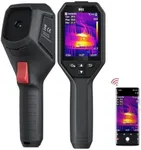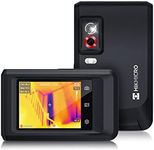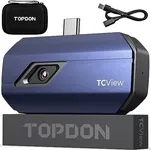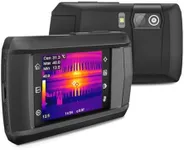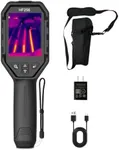Buying Guide for the Best Thermal Security Cameras
When choosing a thermal security camera, it's important to understand the key specifications that will determine how well the camera meets your needs. Thermal security cameras are used to detect heat signatures, making them ideal for surveillance in low-light or no-light conditions. They can be used for a variety of applications, including perimeter security, building monitoring, and wildlife observation. To make an informed decision, you should consider the following key specifications and how they align with your specific requirements.ResolutionResolution refers to the number of pixels in the thermal image. Higher resolution provides more detail, which can be crucial for identifying objects or individuals. Thermal cameras typically have lower resolution compared to visible light cameras, but higher resolution models are available. For general surveillance, a lower resolution may suffice, but for detailed monitoring or identification purposes, a higher resolution is recommended.
Detection RangeDetection range is the maximum distance at which the camera can detect a heat source. This is important for determining how far away you can monitor activity. Short-range cameras are suitable for indoor use or small outdoor areas, while long-range cameras are better for large outdoor spaces or perimeter security. Consider the size of the area you need to monitor when choosing the detection range.
Field of View (FOV)Field of View (FOV) is the extent of the observable area the camera can capture. A wider FOV allows the camera to cover a larger area, which is useful for monitoring open spaces. However, a narrower FOV can provide more detail in a specific area. Choose a FOV based on whether you need broad coverage or detailed monitoring of a particular spot.
Temperature SensitivityTemperature sensitivity, also known as thermal sensitivity, indicates the smallest temperature difference the camera can detect. Higher sensitivity allows the camera to detect smaller temperature variations, which can be important for identifying subtle changes or small objects. For general security purposes, moderate sensitivity may be sufficient, but for applications requiring precise temperature detection, higher sensitivity is preferable.
Image Refresh RateImage refresh rate, measured in Hertz (Hz), is the frequency at which the camera updates the thermal image. A higher refresh rate provides smoother video and is better for capturing fast-moving objects. Lower refresh rates may result in choppier video but can be adequate for static or slow-moving subjects. Consider the typical movement speed of the objects you need to monitor when selecting the refresh rate.
Weather ResistanceWeather resistance indicates how well the camera can withstand environmental conditions such as rain, dust, and extreme temperatures. This is crucial for outdoor installations where the camera will be exposed to the elements. Look for cameras with a high IP (Ingress Protection) rating for better durability in harsh conditions. Ensure the camera's weather resistance matches the environmental conditions of your installation site.
Integration and ConnectivityIntegration and connectivity refer to how the camera connects to your existing security system and other devices. This includes wired or wireless connections, compatibility with network protocols, and support for remote access. Ensure the camera can easily integrate with your current setup and offers the connectivity options you need for monitoring and control.
